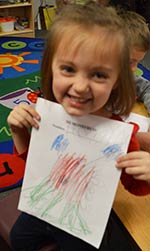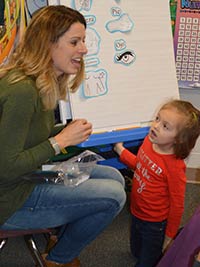Cabeza, hombros, rodillas, pies.
That’s the Spanish version of the children’s song “Head, Shoulders, Knees and Toes,” which McFall Elementary kindergartners were singing during their once-a-week Spanish lesson.
The class got its start this year when kindergarten mom Lyndsey Carpenter moved to the district and asked about Spanish immersion classes at the school.
The district didn’t have that program, so Curriculum Director Kim Chausow and Carpenter, a Spanish teacher for K-12 Online, created a volunteer kit to begin Spanish instruction in kindergarten with the goal of reaching other grades over time.
“Research says if you offer another language, earlier is best,” Chausow said.

Kindergarten teacher Jasmine Koster agrees. “Children of this age much more easily absorb new language.”
Knowing other languages is valuable for landing a job today and will become even more so, both educators said.
Despite the increasing importance of speaking different languages, the U.S. lags behind teaching them, Carpenter noted. In many other countries, students speak three to four languages.
“We’re behind,” she said. “We still look at a second language as an optional thing to do to travel.”
Knowing another language will be valuable in the future for more than just getting a good job, Koster said. “It’s a way to prepare them for diversity outside of school.”
Carpenter said she hopes learning Spanish will broaden students’ world view. “They’ll be more kind and understanding to people of other cultures,” she said. “I think that’s just as valuable as learning the language itself.”
What the Kindergartners Think
“Draw your three noses wherever you want,” Carpenter tells students during a recent session. A handout lists in Spanish the number of body parts they are to use to draw a monster on another sheet of paper.
“We get to make monsters. That’s cool,” says kindergartner Braylee Tep. Nicolas Ruth says he likes the games they play to help them learn the language. And Levi Moredick is already thinking of the future. “I want to learn everything about Spanish.”
Koster sees her students get excited about going home and teaching Mom and Dad a lesson or two. “They look forward to Friday,” she says. “They know they’re going to be taking away something new. No one ever yawns during this.”

A Different Way to Volunteer
Chausow is especially proud of the way the Spanish class came to be. “It’s very unique,” she said. “It comes from a parent asking a question, and by problem-solving together, we came up with creative answer. Giving can be your time and talent. It doesn’t have to be money.”
Carpenter, who has a master’s degree in education with certification in Spanish and health education, said she was impressed by how quickly her idea was accepted and put into operation.
“We moved to Middleville because it’s friendly and welcoming,” she said. “I just asked at registration and said ‘I have a skill I’d love to be able to share,’ and they said ‘Let’s go for it!’ ”
Grants from the Barry Community Foundation and Thornapple Kellogg Area Enrichment Foundation have helped pay for books and supplies. The school plans to take the program into more kindergartenand first grade classes next year.
CONNECT
Why Kids Get Ahead Learning a Second Language









